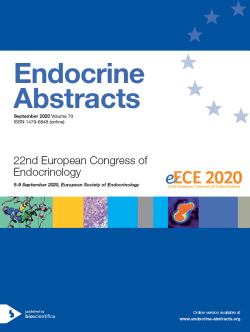
22nd European Congress of Endocrinology
Online
05 Sep 2020 - 09 Sep 2020
Oral Communications
Pituitary and Neuroendocrinology
ea0070oc4.1 | Pituitary and Neuroendocrinology | ECE2020
Quantitative mRNA expression of PROK2, DUSP6, and WDR11 in peripheral blood as diagnostic criteria for central hypogonadism
Loktionova Anna , Ilovayskaya Irena , Nefedova Lidia
ea0070oc4.2 | Pituitary and Neuroendocrinology | ECE2020
Both ghrelin deletion and unacylated ghrelin overexpression preserve muscles in aging mice
Agosti Emanuela , De Feudis Marilisa , Angelino Elia , Belli Roberta , Alves Teixeira Maraiza , Zaggia Ivan , Raiteri Tommaso , Scircoli Andrea , Graziani Andrea , Prodam Flavia , Sanpaolesi Maurilio , Costelli Paola , Ferraro Elisabetta , Reano Simone , Filigheddu Nicoletta
ea0070oc4.3 | Pituitary and Neuroendocrinology | ECE2020
Clinical implications of Pan-genomic classification of pituitary neuroendocrine tumours
Villa Chiara , Neou Mario , Armignacco Roberta , Anne Jouinot Anne , Raffin-Sanson Marie-Laure , Septier Amandine , Perlemoine Karine , Bernier Michèle , Baussart Bertrand , Bertherat Jerome , Gaillard Stéphan , Assié Guillaume
ea0070oc4.4 | Pituitary and Neuroendocrinology | ECE2020
Thyrotropin/Thyrotropin receptor signaling deficiency impairs spatial learning and memory
Luan Sisi , Hou Xu , He Zhao , Zhao Jiajun
ea0070oc4.5 | Pituitary and Neuroendocrinology | ECE2020
Durability of response and gender-based analysis from the LINC3 trial of osilodrostat in the treatment in cushing’s disease
Pivonello Rosario , Fleseriu Maria , Newell-Price John , Xavier Bertagna , James Findling , Akira Shimatsu , Feng Gu , Richard Auchus , Rattana Leelawattana , Jig Lee Eun , Hee Kim Jung , Andre Lacroix , Biller Beverly
ea0070oc4.6 | Pituitary and Neuroendocrinology | ECE2020
Results from the phase 3, randomized, double-blind, placebo-controlled OPTIMAL study of oral octreotide capsules in adult patients with acromegaly
Samson Susan , Nachtigall Lisa , Fleseriu Maria , Gordon Murray , Ludlam William , Patou Gary , Haviv Asi , Molitch Mark E , Biermasz Nienke , Strasburger Christian J , Kennedy Laurence , Melmed Shlomo
ea0070oc4.7 | Pituitary and Neuroendocrinology | ECE2020
Fluid restriction results in a modest rise in plasma sodium concentration in chronic hyponatraemia due to SIAD; results of a prospective randomised controlled trial
Garrahy Aoife , Galloway Iona , Hannon Anne Marie , Dineen Rosemary , O’Kelly Patrick , Tormey William , O’Reilly Michael , Williams David , Sherlock Mark , Thompson Chris



